![]()
![]()
![]()
Use LEFT and RIGHT arrow keys to navigate between flashcards;
Use UP and DOWN arrow keys to flip the card;
H to show hint;
A reads text to speech;
57 Cards in this Set
- Front
- Back
|
Tadasana |
Mountain Pose - Shoulders over hips, hips over knees, knees over ankles and feet - Plumb line through center of torso |
|
|
Utthita Hastasana in Tadasana
|
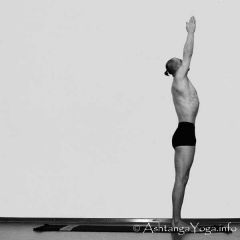
Mountain Pose with hands over head |
|
|
Uttanasana |
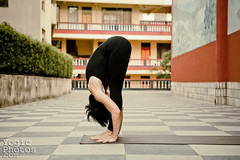
Standing Forward Fold |
|
|
Prasarita Padottanasana
|
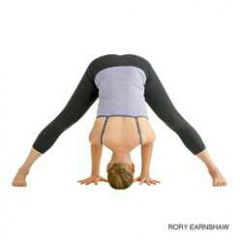
Standing Wide Legged Forward Fold |
|
|
Utthita Hasta Padangustasana |

Hand to Toe
|
|
|
Parsvotanasana |
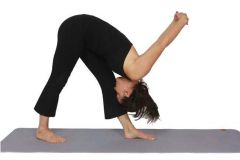
Intense Side Stretch OR Pyramid Stretch |
|
|
Utkatasana |
Chair Pose OR Mighty Pose |
|
|
Virabhadrasana 1
|
Warrior 1 Pose |
|
|
Garudasana
|

Eagle Pose |
|
|
Virabhadrasana 3
|
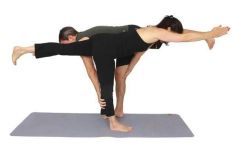
Warrior 3 |
|
|
Parivrtta Parsvakonasana
|

Revolved Side Angle Pose
|
|
|
Parivrtta Trikonasana
|
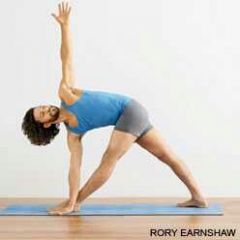
Revolved Triangle Pose
|
|
|
Parivrtta Ardha Chandrasana
|
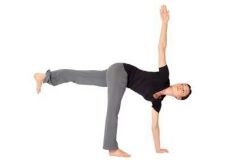
Revolved Half Moon
|
|
|
In asymmetrical neutral standing poses, the position of the back foot is _____ rotation, but the action in the leg/hips is _________ rotation. |
In asymmetrical neutral standing poses, the position of the back foot is external rotation, but the action in the leg/hips is internal rotation. *Generally the feet are aligned heel to heel* |
|
|
In standing neutral poses, the feet align ____ to ____.
|
In standing neutral poses, the feet align heel to heel. |
|
|
In asymmetrical neutrals, the back foot should be _____ to facilitate _____ the hips.
|
In asymmetrical neutrals, the back foot should be angled to facilitate squaring the hips. |
|
|
When the front knee is bent (like vira 1), the weight of the front foot is in the _____ to protect the _____. |
When the front knee is bent (like vira 1), the weight of the front foot is in the heel to protect the knee. |
|
|
The feet press down as the ____ and ____ lift up. |
The feet press down as the arches and ankles lift up. |
|
|
In poses where the torso is upright, create length in the low back by...... |
..... lengthening down through the tailbone (release buttocks toward feet)
...... drawing the low abdomen gently in and up |
|
|
The Three Platforms of Yoga
|
Ankles/feet
Pelvic girdle Shoulder girdle - Tadasana is a great blueprint for 3 Platforms |
|
|
In standing neutral poses, the pelvis should be _____ |
Neutral |
|
|
In vira 1, will the pelvis ever be completely neutral/square? |
The pelvis is unlikely to ever be completely neutral or square because of the position of the back foot and the restriction of the hip flexors. |
|
|
Benefits to symmetrical neutrals....
|
- Easier (good for beginners and people with special conditions) |
|
|
A benefit for all asymmetrial neutrals... |
Cultivate balance |
|
|
Common misalignments for neutral standing poses: |
-Three platforms not in line |
|
|
What is a risk in a forward bend?
|
Hyperextension of knee can create instability and strain on the back of the knee |
|
|
What is a risk in an asymmetrical pose?
|
Back foot not angled enough to help the hips square (which can torque the knee and low back) |
|
|
Why is tadasana the "blueprint pose"?
|
It's the best pose for teaching and imprinting the three platforms; students should seek the stability, activation, and alignment of tadasana in other asanas. |
|
|
What is a modification for tadasana?
|
Feet hip distance apart (good for less stable students--beginners, elderly, pregnant) |
|
|
What is the shoulder girdle mantra? |
-Lift the sternum |
|
|
What is a complementary action?
|
Two instructions or actions that create the same result.
|
|
|
What is a simple action?
|
An action that can't be overdone, doesn't need further instruction to do safely. |
|
|
What are some simple actions?
|
-Lengthen all four sides of the torso |
|
|
What are some instructions you might give to a class for tadasana?
|
feet together, parallel |
|
|
What are some benefits to urdhva hastasana?
|
lengthens the waist |
|
|
What are some instructions you might gives students for urdhva hastasana?
|
feet together, parallel, and pressing firmly and evenly through all four corners |
|
|
Benefits of uttanasana:
|
releases hamstrings/stretches legs |
|
|
What areas are at risk in uttanasana?
|
hamstrings |
|
|
What is a modification for uttanasana?
|
feet hip distance apart (stability, good for tight hamstrings)
|
|
|
Common misalignments in uttanasana:
|
kneecaps not lifted
knees hyperextended back rounded (either bend knees or use block) |
|
|
What are some instructions you might give students for uttanasana?
|
exhale, hinge forward at the hips |
|
|
What are some benefits to prasarita padottanasana? |
stretches hamstrings and inner thigh muscles |
|
|
What areas are at risk in prasarita padottasana?
|
outer ankles
hamstrings back |
|
|
What is the foundation of Prasarita Padottanasna?
|
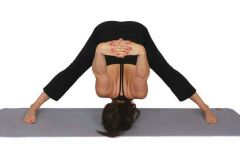
Standing Wide Angle Forward Bend
feet wide (ankles under palms if arms are spread wide to measure) and parallel palms shoulder distance and parallel elbows over wrists crown of head on floor or block |
|
|
What are some instructions you might give your students in Prasarita Padottanasana?
|
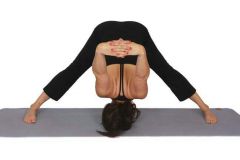
press down evenly through all four corners of your feet
lift arches and ankles up firm the legs by lifting knee caps and inner thighs weight shifts slightly forward to keep hips over heels lengthen torso from your tailbone through crown of your head shoulders away from ears hands parallel and shoulder distance apart |
|
|
Common problems/misalignments in Prasarita Padottanasana:
|

feet not parallel
pelvis not over heels rounded spine shoulders near ears |
|
|
Modifications for Prasarita Padottanasana:
|
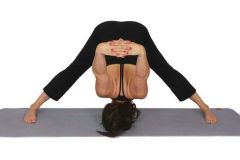
if head easily touches floor, narrow the stance
bend knees slightly to keep spine long block under head toes in if hamstrings are tight blocks under hands to keep spine long |
|
|
Benefits of Utthita Hasta Padangusthasana:
|
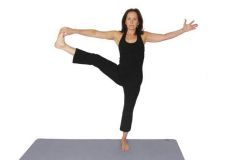
strengths and stretches legs and hips
mental focus balance |
|
|
What are some instructions you might give for Utthita Hasta Padangusthasana? |
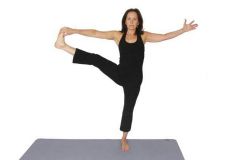
feet begin in parallel, together |
|
|
Common problems/misalignments in Utthita Hasta Padangusthasana:
|

standing leg isn't straight, muscles firmed
hips not level with floor grasping arm pulled forward front body collapsing |
|
|
Modifications for Utthita Hasta Padangusthasana:
|
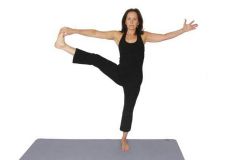
belt for lifted foot
lifted foot placed on a ledge, chair, or wall |
|
|
What does Prasarita mean?
|
Spread out, stretched out. |
|
|
Urdhva Hastasana |
Upward Salute Pose |
|
|
Pelvic Girdle Mantra |
- Roll the inner thighs toward each other and back. - Lift the frontal hip points towards the naval and lengthen the buttocks towards the heels |
|
|
The Foot and Ankle Mantra |
- Press down through the four corners of the feet - Lift the inner arches, and hug the outer ankles in |
|
|
Words or phrases to create ACTION |
|
|
|
Misalignments and Risks of Neutrally Rotated Standing Poses |
|

